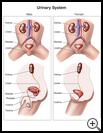
Voiding Cystourethrogram (Bladder Emptying X-ray)
________________________________________________________________________
KEY POINTS
- A voiding cystourethrogram (VCUG) is a test that uses a dye and X-rays to take pictures of the bladder and urethra during urination (voiding) to see how well the bladder and its connecting tubes (the ureters and urethra) are working.
- Tell your healthcare provider if you have had any kidney problems or reactions to iodine-containing foods or chemicals, such as seafood or X-ray contrast dye.
- Ask your healthcare provider how and when you will get your test results and when you can return to your normal activities.
________________________________________________________________________
What is a voiding cystourethrogram?
A voiding cystourethrogram (VCUG) is a test that uses contrast dye and X-rays to take pictures of the bladder and urethra during urination (voiding). It shows how well the bladder and its connecting tubes (the ureters and urethra) are working. The ureters are the tubes that drain urine from the kidneys to the bladder. The urethra is the tube that drains urine from the bladder to outside the body.
When is it used?
This test may be done to see if:
- A man has narrowing of the urethra.
- The bladder has trouble emptying.
- The bladder or urethra has an unusual shape or size.
- A problem with the shape or size of the bladder or urethra is causing repeat urinary tract infections.
- Urine moves from the bladder back up to the kidney.
Ask your healthcare provider about your choices for treatment and the risks.
How do I prepare for this test?
Tell your healthcare provider if you have had any kidney problems or reactions to iodine-containing foods or chemicals, such as seafood or X-ray contrast dye.
What happens during the test?
The procedure may be done in your healthcare provider’s office, outpatient center, or hospital.
First an X-ray will be taken of the abdominal (belly) area. Then, a urinary catheter (a small, thin, soft tube) will be inserted into the bladder. It will be inserted through the opening where urine comes out (the urethra).
You may feel some pain or discomfort when the catheter is inserted.
The catheter will be used to fill the bladder with contrast dye that is easy to see on X-rays. X-rays are taken and viewed on a TV screen by the radiologist. Once the bladder is full, the catheter is removed, so the urethra can be examined with more X-rays while the bladder is emptying.
What happens after the test?
After the test, you can go back to normal daily activities.
Your urine may be pink the first time you urinate after the catheter tube is removed. This is caused by a small amount of blood in the urine. You may also feel some pressure when you urinate. Usually drinking a couple of large glasses of water or other clear liquids will help you urinate without a problem.
Ask your healthcare provider:
- How and when you will get your test results
- How long it will take to recover
- If there are activities you should avoid and when you can return to your normal activities
- How to take care of yourself at home
- What symptoms or problems you should watch for and what to do if you have them
Make sure you know when you should come back for a checkup. Keep all appointments for provider visits or tests.
What are the risks of this procedure?
Every procedure or treatment has risks. Some possible risks of this procedure include:
- You may have an infection or bleeding.
- Rarely, you may have a reaction to the dye.
Ask your healthcare provider how the risks apply to you. Be sure to discuss any other questions or concerns that you may have.

